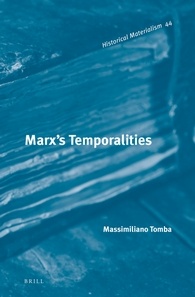Massimiliano Tomba, University of Padua. Translated from the Italian by Peter D. Thomas and Sara R. Farris
The book rethinks the central categories of Marx’s work beyond any philosophy of history, providing a critical analysis of his political and theoretical development from his early writings, to the elaboration of the critique of political economy and his final anthropological studies on pre-individualistic and communist forms. The study aims to integrate the paradigm of the spatialisation of time with that of the temporalisation of space, showing how capital places diverse temporalities into hierarchies that incessantly produce and reproduce new forms of class struggle. An adequate historiographical paradigm for globalised capitalism has to consider the plurality of temporal layers that are combined and come into conflict in the violently unifying historical dimension of modernity.
Biographical note
Massimiliano Tomba is Professor of Philosophy of Human Rights at the University of Padua. He has published many books, translations and articles, including Crisis and Critique in Bruno Bauer (2002) and La vera politica. Kant e Benjamin (2006).
Readership
All interested in Marx’s thought, the concept of historical time in the modern world and the history of political thought and philosophy.
Reviews
[…] both works [including Tomba’s “Marx’s Temporalities] are exciting and outstanding achievements in academic Marxism, and we should applaud the editors of the Historical Materialism Book Series for making this work available to an English language readership.
Christian Lotz, Marx & Philosophy, 9 May 2014
[… ] timely and often brilliantly suggestive and informed reading of how Marxism lost its way and failed to account for the changes that Marx introduced in the 1860s and 1870s, […].
Harry Harootunian, Radical Philosophy, 178 (March/April 2013), pp. 40-43
Table of contents
Preface
Chapter One: The Historical Materialist
Appendix One: Marx as Historical Materialist. Re-reading the Eighteenth Brumaire
Chapter Two: A New Phenotype
Chapter Three: Capital as Phantasmagoria
Appendix Two: A Contribution to the Historiography of Layers of Time
Bibliography
Index

